University Assignment: Analysing a Sustainable Business Report
VerifiedAdded on 2022/12/23
|10
|2742
|1
Report
AI Summary
This report analyzes the concept of sustainable business practices, focusing on the UK government's 'clean growth' strategy and its implications for businesses. It explores key terms such as the Triple Bottom Line (TBL), Five Capitals, Natural Capitalism, Cradle to Cradle, and the Circular Economy, highlighting their roles in achieving sustainability. The report uses Jaguar Land Rover as a case study to examine the challenges and risks associated with environmental impact, particularly in the context of TBL and Natural Capitalism. It assesses Jaguar Land Rover's performance, emphasizing its shortcomings in adopting sustainable practices and the barriers it faces, including infrastructure limitations, technological constraints, and consumer behavior. The report concludes by emphasizing the need for Jaguar Land Rover to prioritize TBL and Natural Capitalism principles to ensure long-term profitability and success in the face of growing environmental concerns and regulatory pressures. The analysis underscores the importance of electric vehicles and the mitigation of identified barriers to achieve clean growth and business sustainability.
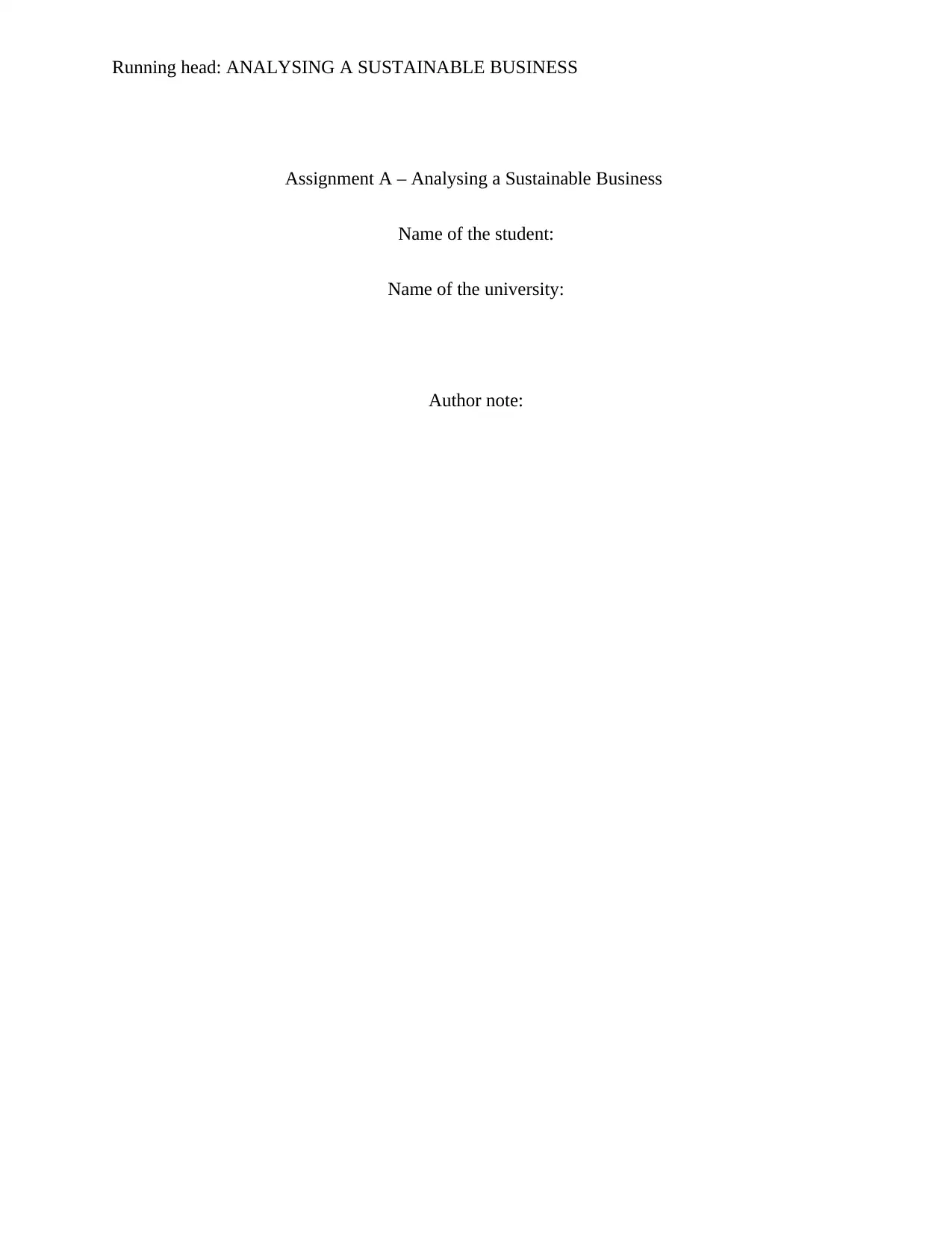
Running head: ANALYSING A SUSTAINABLE BUSINESS
Assignment A – Analysing a Sustainable Business
Name of the student:
Name of the university:
Author note:
Assignment A – Analysing a Sustainable Business
Name of the student:
Name of the university:
Author note:
Paraphrase This Document
Need a fresh take? Get an instant paraphrase of this document with our AI Paraphraser
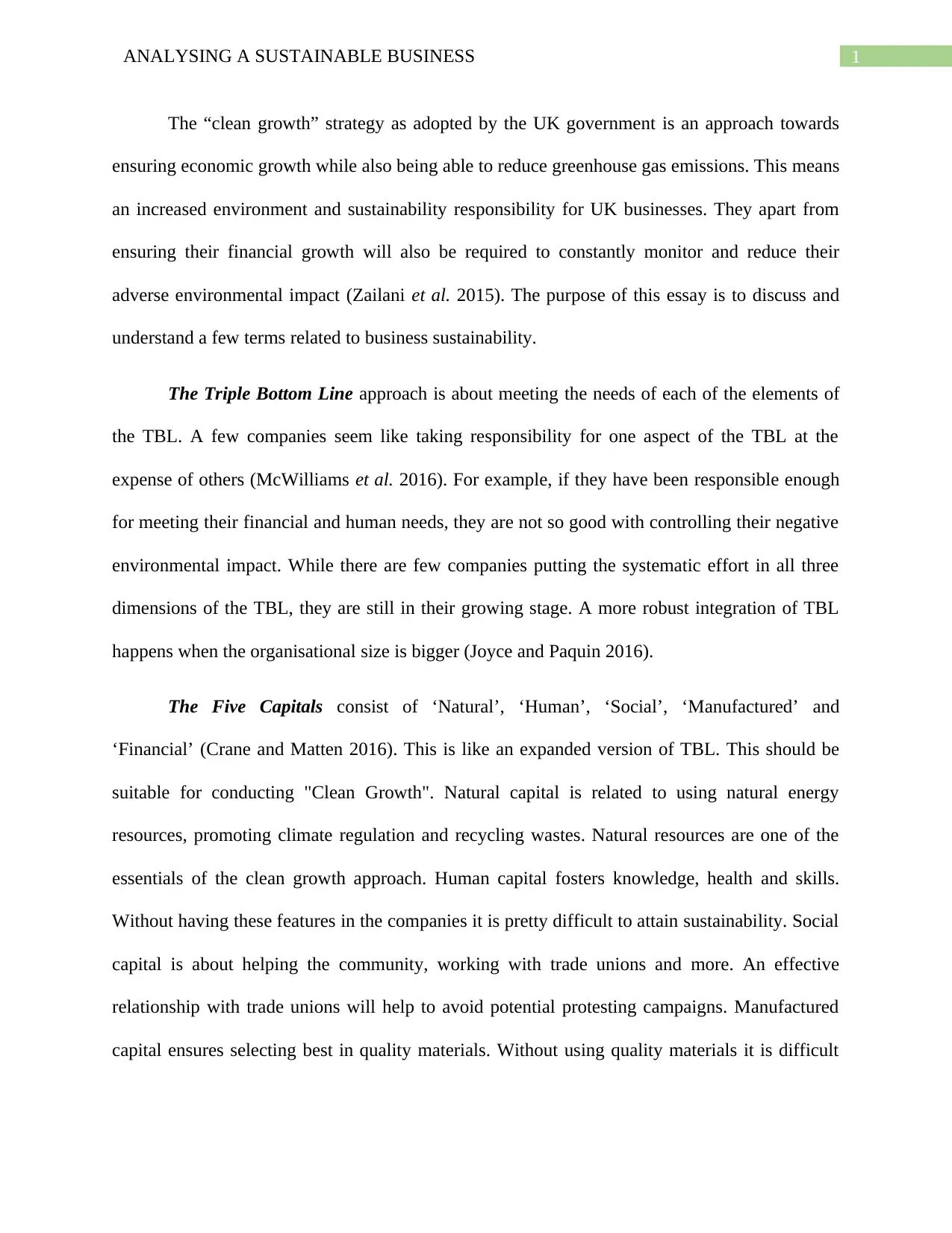
1ANALYSING A SUSTAINABLE BUSINESS
The “clean growth” strategy as adopted by the UK government is an approach towards
ensuring economic growth while also being able to reduce greenhouse gas emissions. This means
an increased environment and sustainability responsibility for UK businesses. They apart from
ensuring their financial growth will also be required to constantly monitor and reduce their
adverse environmental impact (Zailani et al. 2015). The purpose of this essay is to discuss and
understand a few terms related to business sustainability.
The Triple Bottom Line approach is about meeting the needs of each of the elements of
the TBL. A few companies seem like taking responsibility for one aspect of the TBL at the
expense of others (McWilliams et al. 2016). For example, if they have been responsible enough
for meeting their financial and human needs, they are not so good with controlling their negative
environmental impact. While there are few companies putting the systematic effort in all three
dimensions of the TBL, they are still in their growing stage. A more robust integration of TBL
happens when the organisational size is bigger (Joyce and Paquin 2016).
The Five Capitals consist of ‘Natural’, ‘Human’, ‘Social’, ‘Manufactured’ and
‘Financial’ (Crane and Matten 2016). This is like an expanded version of TBL. This should be
suitable for conducting "Clean Growth". Natural capital is related to using natural energy
resources, promoting climate regulation and recycling wastes. Natural resources are one of the
essentials of the clean growth approach. Human capital fosters knowledge, health and skills.
Without having these features in the companies it is pretty difficult to attain sustainability. Social
capital is about helping the community, working with trade unions and more. An effective
relationship with trade unions will help to avoid potential protesting campaigns. Manufactured
capital ensures selecting best in quality materials. Without using quality materials it is difficult
The “clean growth” strategy as adopted by the UK government is an approach towards
ensuring economic growth while also being able to reduce greenhouse gas emissions. This means
an increased environment and sustainability responsibility for UK businesses. They apart from
ensuring their financial growth will also be required to constantly monitor and reduce their
adverse environmental impact (Zailani et al. 2015). The purpose of this essay is to discuss and
understand a few terms related to business sustainability.
The Triple Bottom Line approach is about meeting the needs of each of the elements of
the TBL. A few companies seem like taking responsibility for one aspect of the TBL at the
expense of others (McWilliams et al. 2016). For example, if they have been responsible enough
for meeting their financial and human needs, they are not so good with controlling their negative
environmental impact. While there are few companies putting the systematic effort in all three
dimensions of the TBL, they are still in their growing stage. A more robust integration of TBL
happens when the organisational size is bigger (Joyce and Paquin 2016).
The Five Capitals consist of ‘Natural’, ‘Human’, ‘Social’, ‘Manufactured’ and
‘Financial’ (Crane and Matten 2016). This is like an expanded version of TBL. This should be
suitable for conducting "Clean Growth". Natural capital is related to using natural energy
resources, promoting climate regulation and recycling wastes. Natural resources are one of the
essentials of the clean growth approach. Human capital fosters knowledge, health and skills.
Without having these features in the companies it is pretty difficult to attain sustainability. Social
capital is about helping the community, working with trade unions and more. An effective
relationship with trade unions will help to avoid potential protesting campaigns. Manufactured
capital ensures selecting best in quality materials. Without using quality materials it is difficult
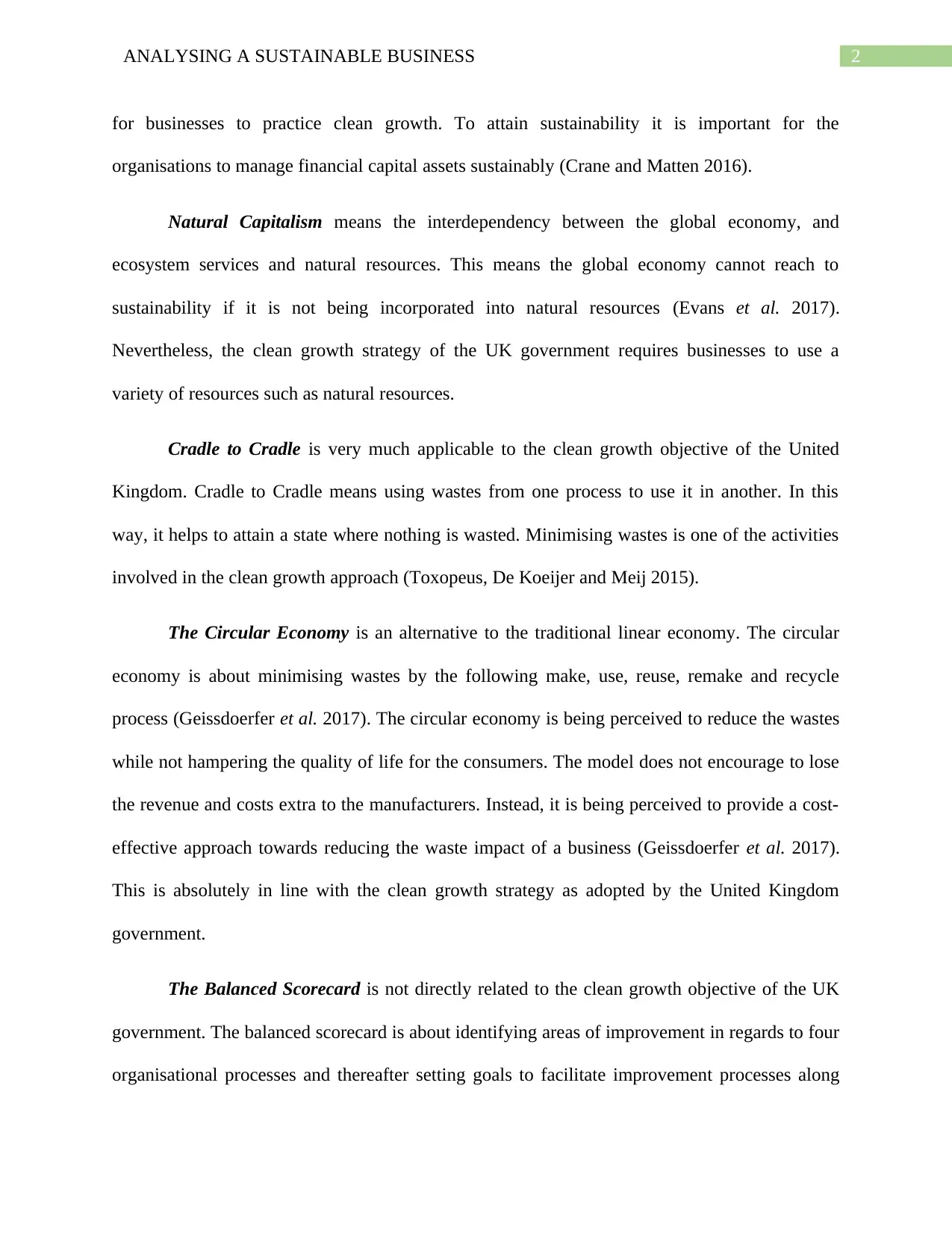
2ANALYSING A SUSTAINABLE BUSINESS
for businesses to practice clean growth. To attain sustainability it is important for the
organisations to manage financial capital assets sustainably (Crane and Matten 2016).
Natural Capitalism means the interdependency between the global economy, and
ecosystem services and natural resources. This means the global economy cannot reach to
sustainability if it is not being incorporated into natural resources (Evans et al. 2017).
Nevertheless, the clean growth strategy of the UK government requires businesses to use a
variety of resources such as natural resources.
Cradle to Cradle is very much applicable to the clean growth objective of the United
Kingdom. Cradle to Cradle means using wastes from one process to use it in another. In this
way, it helps to attain a state where nothing is wasted. Minimising wastes is one of the activities
involved in the clean growth approach (Toxopeus, De Koeijer and Meij 2015).
The Circular Economy is an alternative to the traditional linear economy. The circular
economy is about minimising wastes by the following make, use, reuse, remake and recycle
process (Geissdoerfer et al. 2017). The circular economy is being perceived to reduce the wastes
while not hampering the quality of life for the consumers. The model does not encourage to lose
the revenue and costs extra to the manufacturers. Instead, it is being perceived to provide a cost-
effective approach towards reducing the waste impact of a business (Geissdoerfer et al. 2017).
This is absolutely in line with the clean growth strategy as adopted by the United Kingdom
government.
The Balanced Scorecard is not directly related to the clean growth objective of the UK
government. The balanced scorecard is about identifying areas of improvement in regards to four
organisational processes and thereafter setting goals to facilitate improvement processes along
for businesses to practice clean growth. To attain sustainability it is important for the
organisations to manage financial capital assets sustainably (Crane and Matten 2016).
Natural Capitalism means the interdependency between the global economy, and
ecosystem services and natural resources. This means the global economy cannot reach to
sustainability if it is not being incorporated into natural resources (Evans et al. 2017).
Nevertheless, the clean growth strategy of the UK government requires businesses to use a
variety of resources such as natural resources.
Cradle to Cradle is very much applicable to the clean growth objective of the United
Kingdom. Cradle to Cradle means using wastes from one process to use it in another. In this
way, it helps to attain a state where nothing is wasted. Minimising wastes is one of the activities
involved in the clean growth approach (Toxopeus, De Koeijer and Meij 2015).
The Circular Economy is an alternative to the traditional linear economy. The circular
economy is about minimising wastes by the following make, use, reuse, remake and recycle
process (Geissdoerfer et al. 2017). The circular economy is being perceived to reduce the wastes
while not hampering the quality of life for the consumers. The model does not encourage to lose
the revenue and costs extra to the manufacturers. Instead, it is being perceived to provide a cost-
effective approach towards reducing the waste impact of a business (Geissdoerfer et al. 2017).
This is absolutely in line with the clean growth strategy as adopted by the United Kingdom
government.
The Balanced Scorecard is not directly related to the clean growth objective of the UK
government. The balanced scorecard is about identifying areas of improvement in regards to four
organisational processes and thereafter setting goals to facilitate improvement processes along
⊘ This is a preview!⊘
Do you want full access?
Subscribe today to unlock all pages.

Trusted by 1+ million students worldwide
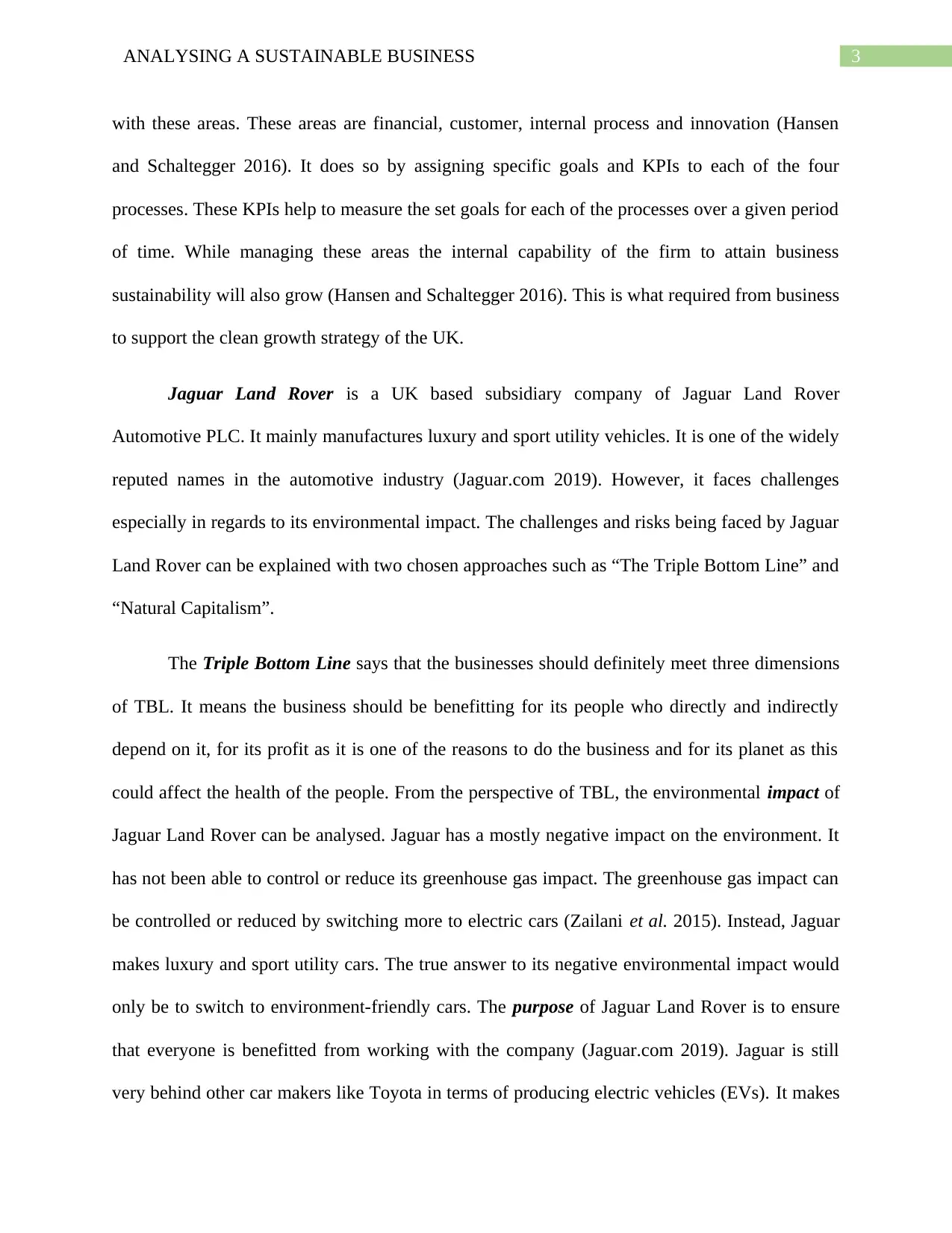
3ANALYSING A SUSTAINABLE BUSINESS
with these areas. These areas are financial, customer, internal process and innovation (Hansen
and Schaltegger 2016). It does so by assigning specific goals and KPIs to each of the four
processes. These KPIs help to measure the set goals for each of the processes over a given period
of time. While managing these areas the internal capability of the firm to attain business
sustainability will also grow (Hansen and Schaltegger 2016). This is what required from business
to support the clean growth strategy of the UK.
Jaguar Land Rover is a UK based subsidiary company of Jaguar Land Rover
Automotive PLC. It mainly manufactures luxury and sport utility vehicles. It is one of the widely
reputed names in the automotive industry (Jaguar.com 2019). However, it faces challenges
especially in regards to its environmental impact. The challenges and risks being faced by Jaguar
Land Rover can be explained with two chosen approaches such as “The Triple Bottom Line” and
“Natural Capitalism”.
The Triple Bottom Line says that the businesses should definitely meet three dimensions
of TBL. It means the business should be benefitting for its people who directly and indirectly
depend on it, for its profit as it is one of the reasons to do the business and for its planet as this
could affect the health of the people. From the perspective of TBL, the environmental impact of
Jaguar Land Rover can be analysed. Jaguar has a mostly negative impact on the environment. It
has not been able to control or reduce its greenhouse gas impact. The greenhouse gas impact can
be controlled or reduced by switching more to electric cars (Zailani et al. 2015). Instead, Jaguar
makes luxury and sport utility cars. The true answer to its negative environmental impact would
only be to switch to environment-friendly cars. The purpose of Jaguar Land Rover is to ensure
that everyone is benefitted from working with the company (Jaguar.com 2019). Jaguar is still
very behind other car makers like Toyota in terms of producing electric vehicles (EVs). It makes
with these areas. These areas are financial, customer, internal process and innovation (Hansen
and Schaltegger 2016). It does so by assigning specific goals and KPIs to each of the four
processes. These KPIs help to measure the set goals for each of the processes over a given period
of time. While managing these areas the internal capability of the firm to attain business
sustainability will also grow (Hansen and Schaltegger 2016). This is what required from business
to support the clean growth strategy of the UK.
Jaguar Land Rover is a UK based subsidiary company of Jaguar Land Rover
Automotive PLC. It mainly manufactures luxury and sport utility vehicles. It is one of the widely
reputed names in the automotive industry (Jaguar.com 2019). However, it faces challenges
especially in regards to its environmental impact. The challenges and risks being faced by Jaguar
Land Rover can be explained with two chosen approaches such as “The Triple Bottom Line” and
“Natural Capitalism”.
The Triple Bottom Line says that the businesses should definitely meet three dimensions
of TBL. It means the business should be benefitting for its people who directly and indirectly
depend on it, for its profit as it is one of the reasons to do the business and for its planet as this
could affect the health of the people. From the perspective of TBL, the environmental impact of
Jaguar Land Rover can be analysed. Jaguar has a mostly negative impact on the environment. It
has not been able to control or reduce its greenhouse gas impact. The greenhouse gas impact can
be controlled or reduced by switching more to electric cars (Zailani et al. 2015). Instead, Jaguar
makes luxury and sport utility cars. The true answer to its negative environmental impact would
only be to switch to environment-friendly cars. The purpose of Jaguar Land Rover is to ensure
that everyone is benefitted from working with the company (Jaguar.com 2019). Jaguar is still
very behind other car makers like Toyota in terms of producing electric vehicles (EVs). It makes
Paraphrase This Document
Need a fresh take? Get an instant paraphrase of this document with our AI Paraphraser
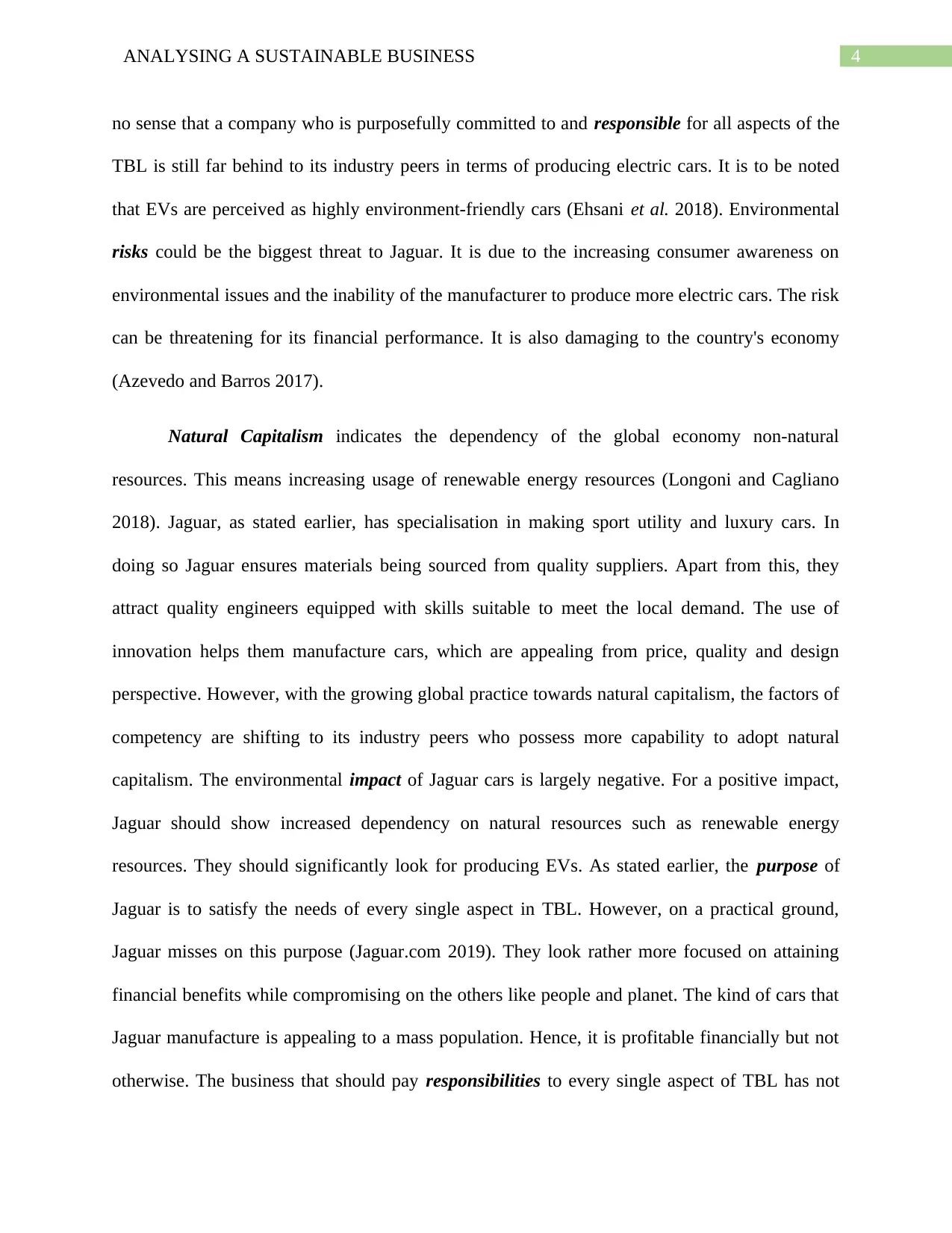
4ANALYSING A SUSTAINABLE BUSINESS
no sense that a company who is purposefully committed to and responsible for all aspects of the
TBL is still far behind to its industry peers in terms of producing electric cars. It is to be noted
that EVs are perceived as highly environment-friendly cars (Ehsani et al. 2018). Environmental
risks could be the biggest threat to Jaguar. It is due to the increasing consumer awareness on
environmental issues and the inability of the manufacturer to produce more electric cars. The risk
can be threatening for its financial performance. It is also damaging to the country's economy
(Azevedo and Barros 2017).
Natural Capitalism indicates the dependency of the global economy non-natural
resources. This means increasing usage of renewable energy resources (Longoni and Cagliano
2018). Jaguar, as stated earlier, has specialisation in making sport utility and luxury cars. In
doing so Jaguar ensures materials being sourced from quality suppliers. Apart from this, they
attract quality engineers equipped with skills suitable to meet the local demand. The use of
innovation helps them manufacture cars, which are appealing from price, quality and design
perspective. However, with the growing global practice towards natural capitalism, the factors of
competency are shifting to its industry peers who possess more capability to adopt natural
capitalism. The environmental impact of Jaguar cars is largely negative. For a positive impact,
Jaguar should show increased dependency on natural resources such as renewable energy
resources. They should significantly look for producing EVs. As stated earlier, the purpose of
Jaguar is to satisfy the needs of every single aspect in TBL. However, on a practical ground,
Jaguar misses on this purpose (Jaguar.com 2019). They look rather more focused on attaining
financial benefits while compromising on the others like people and planet. The kind of cars that
Jaguar manufacture is appealing to a mass population. Hence, it is profitable financially but not
otherwise. The business that should pay responsibilities to every single aspect of TBL has not
no sense that a company who is purposefully committed to and responsible for all aspects of the
TBL is still far behind to its industry peers in terms of producing electric cars. It is to be noted
that EVs are perceived as highly environment-friendly cars (Ehsani et al. 2018). Environmental
risks could be the biggest threat to Jaguar. It is due to the increasing consumer awareness on
environmental issues and the inability of the manufacturer to produce more electric cars. The risk
can be threatening for its financial performance. It is also damaging to the country's economy
(Azevedo and Barros 2017).
Natural Capitalism indicates the dependency of the global economy non-natural
resources. This means increasing usage of renewable energy resources (Longoni and Cagliano
2018). Jaguar, as stated earlier, has specialisation in making sport utility and luxury cars. In
doing so Jaguar ensures materials being sourced from quality suppliers. Apart from this, they
attract quality engineers equipped with skills suitable to meet the local demand. The use of
innovation helps them manufacture cars, which are appealing from price, quality and design
perspective. However, with the growing global practice towards natural capitalism, the factors of
competency are shifting to its industry peers who possess more capability to adopt natural
capitalism. The environmental impact of Jaguar cars is largely negative. For a positive impact,
Jaguar should show increased dependency on natural resources such as renewable energy
resources. They should significantly look for producing EVs. As stated earlier, the purpose of
Jaguar is to satisfy the needs of every single aspect in TBL. However, on a practical ground,
Jaguar misses on this purpose (Jaguar.com 2019). They look rather more focused on attaining
financial benefits while compromising on the others like people and planet. The kind of cars that
Jaguar manufacture is appealing to a mass population. Hence, it is profitable financially but not
otherwise. The business that should pay responsibilities to every single aspect of TBL has not
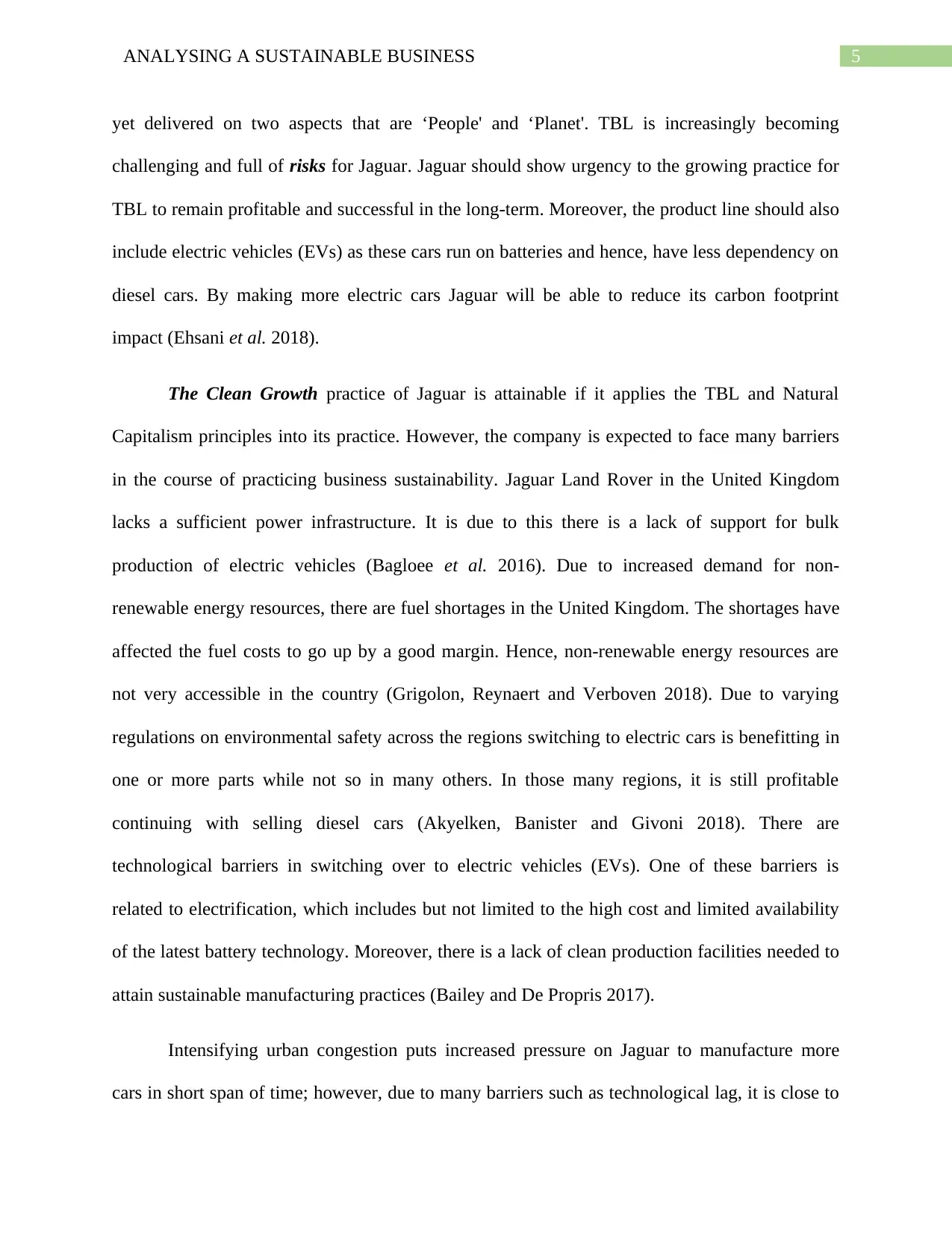
5ANALYSING A SUSTAINABLE BUSINESS
yet delivered on two aspects that are ‘People' and ‘Planet'. TBL is increasingly becoming
challenging and full of risks for Jaguar. Jaguar should show urgency to the growing practice for
TBL to remain profitable and successful in the long-term. Moreover, the product line should also
include electric vehicles (EVs) as these cars run on batteries and hence, have less dependency on
diesel cars. By making more electric cars Jaguar will be able to reduce its carbon footprint
impact (Ehsani et al. 2018).
The Clean Growth practice of Jaguar is attainable if it applies the TBL and Natural
Capitalism principles into its practice. However, the company is expected to face many barriers
in the course of practicing business sustainability. Jaguar Land Rover in the United Kingdom
lacks a sufficient power infrastructure. It is due to this there is a lack of support for bulk
production of electric vehicles (Bagloee et al. 2016). Due to increased demand for non-
renewable energy resources, there are fuel shortages in the United Kingdom. The shortages have
affected the fuel costs to go up by a good margin. Hence, non-renewable energy resources are
not very accessible in the country (Grigolon, Reynaert and Verboven 2018). Due to varying
regulations on environmental safety across the regions switching to electric cars is benefitting in
one or more parts while not so in many others. In those many regions, it is still profitable
continuing with selling diesel cars (Akyelken, Banister and Givoni 2018). There are
technological barriers in switching over to electric vehicles (EVs). One of these barriers is
related to electrification, which includes but not limited to the high cost and limited availability
of the latest battery technology. Moreover, there is a lack of clean production facilities needed to
attain sustainable manufacturing practices (Bailey and De Propris 2017).
Intensifying urban congestion puts increased pressure on Jaguar to manufacture more
cars in short span of time; however, due to many barriers such as technological lag, it is close to
yet delivered on two aspects that are ‘People' and ‘Planet'. TBL is increasingly becoming
challenging and full of risks for Jaguar. Jaguar should show urgency to the growing practice for
TBL to remain profitable and successful in the long-term. Moreover, the product line should also
include electric vehicles (EVs) as these cars run on batteries and hence, have less dependency on
diesel cars. By making more electric cars Jaguar will be able to reduce its carbon footprint
impact (Ehsani et al. 2018).
The Clean Growth practice of Jaguar is attainable if it applies the TBL and Natural
Capitalism principles into its practice. However, the company is expected to face many barriers
in the course of practicing business sustainability. Jaguar Land Rover in the United Kingdom
lacks a sufficient power infrastructure. It is due to this there is a lack of support for bulk
production of electric vehicles (Bagloee et al. 2016). Due to increased demand for non-
renewable energy resources, there are fuel shortages in the United Kingdom. The shortages have
affected the fuel costs to go up by a good margin. Hence, non-renewable energy resources are
not very accessible in the country (Grigolon, Reynaert and Verboven 2018). Due to varying
regulations on environmental safety across the regions switching to electric cars is benefitting in
one or more parts while not so in many others. In those many regions, it is still profitable
continuing with selling diesel cars (Akyelken, Banister and Givoni 2018). There are
technological barriers in switching over to electric vehicles (EVs). One of these barriers is
related to electrification, which includes but not limited to the high cost and limited availability
of the latest battery technology. Moreover, there is a lack of clean production facilities needed to
attain sustainable manufacturing practices (Bailey and De Propris 2017).
Intensifying urban congestion puts increased pressure on Jaguar to manufacture more
cars in short span of time; however, due to many barriers such as technological lag, it is close to
⊘ This is a preview!⊘
Do you want full access?
Subscribe today to unlock all pages.

Trusted by 1+ million students worldwide
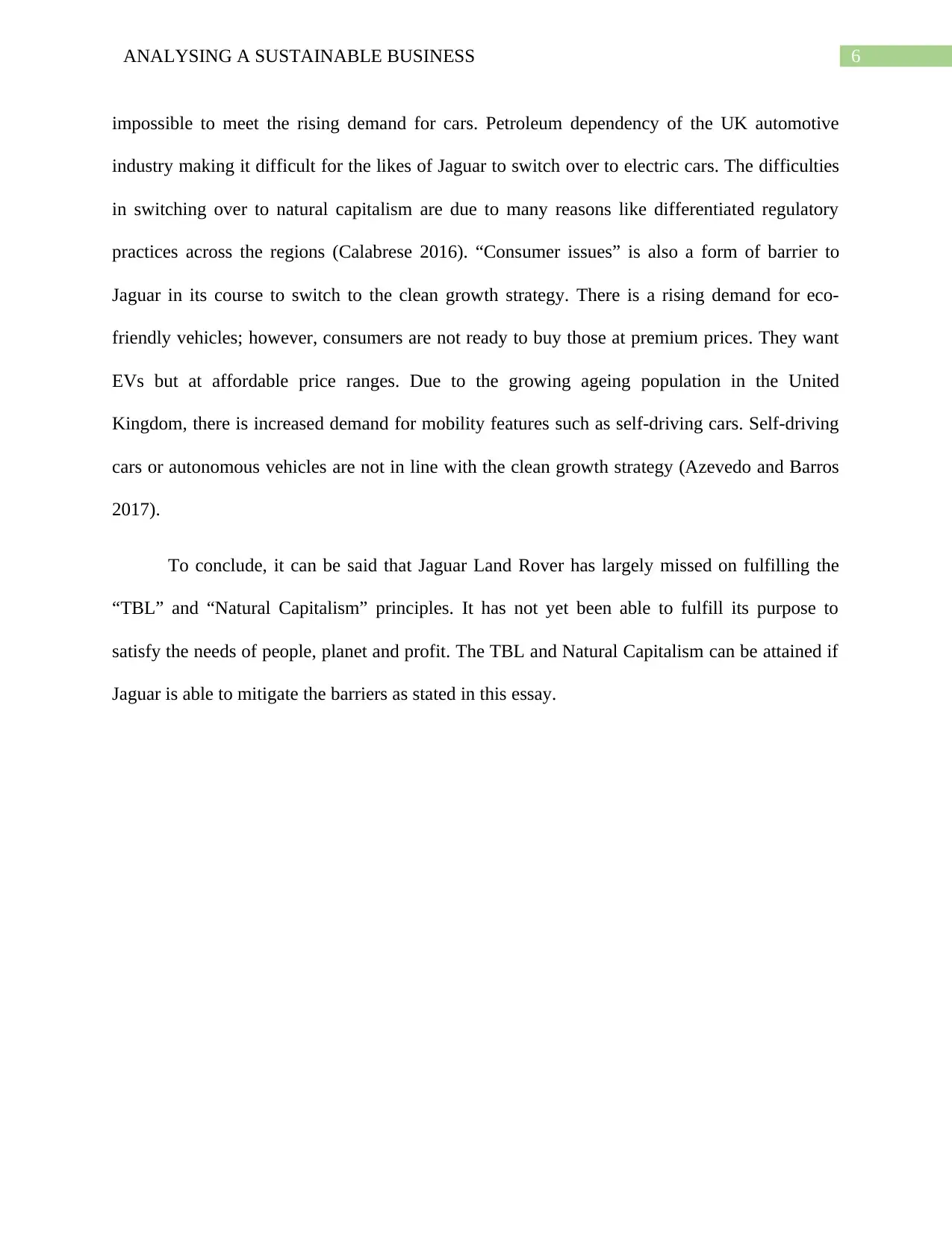
6ANALYSING A SUSTAINABLE BUSINESS
impossible to meet the rising demand for cars. Petroleum dependency of the UK automotive
industry making it difficult for the likes of Jaguar to switch over to electric cars. The difficulties
in switching over to natural capitalism are due to many reasons like differentiated regulatory
practices across the regions (Calabrese 2016). “Consumer issues” is also a form of barrier to
Jaguar in its course to switch to the clean growth strategy. There is a rising demand for eco-
friendly vehicles; however, consumers are not ready to buy those at premium prices. They want
EVs but at affordable price ranges. Due to the growing ageing population in the United
Kingdom, there is increased demand for mobility features such as self-driving cars. Self-driving
cars or autonomous vehicles are not in line with the clean growth strategy (Azevedo and Barros
2017).
To conclude, it can be said that Jaguar Land Rover has largely missed on fulfilling the
“TBL” and “Natural Capitalism” principles. It has not yet been able to fulfill its purpose to
satisfy the needs of people, planet and profit. The TBL and Natural Capitalism can be attained if
Jaguar is able to mitigate the barriers as stated in this essay.
impossible to meet the rising demand for cars. Petroleum dependency of the UK automotive
industry making it difficult for the likes of Jaguar to switch over to electric cars. The difficulties
in switching over to natural capitalism are due to many reasons like differentiated regulatory
practices across the regions (Calabrese 2016). “Consumer issues” is also a form of barrier to
Jaguar in its course to switch to the clean growth strategy. There is a rising demand for eco-
friendly vehicles; however, consumers are not ready to buy those at premium prices. They want
EVs but at affordable price ranges. Due to the growing ageing population in the United
Kingdom, there is increased demand for mobility features such as self-driving cars. Self-driving
cars or autonomous vehicles are not in line with the clean growth strategy (Azevedo and Barros
2017).
To conclude, it can be said that Jaguar Land Rover has largely missed on fulfilling the
“TBL” and “Natural Capitalism” principles. It has not yet been able to fulfill its purpose to
satisfy the needs of people, planet and profit. The TBL and Natural Capitalism can be attained if
Jaguar is able to mitigate the barriers as stated in this essay.
Paraphrase This Document
Need a fresh take? Get an instant paraphrase of this document with our AI Paraphraser
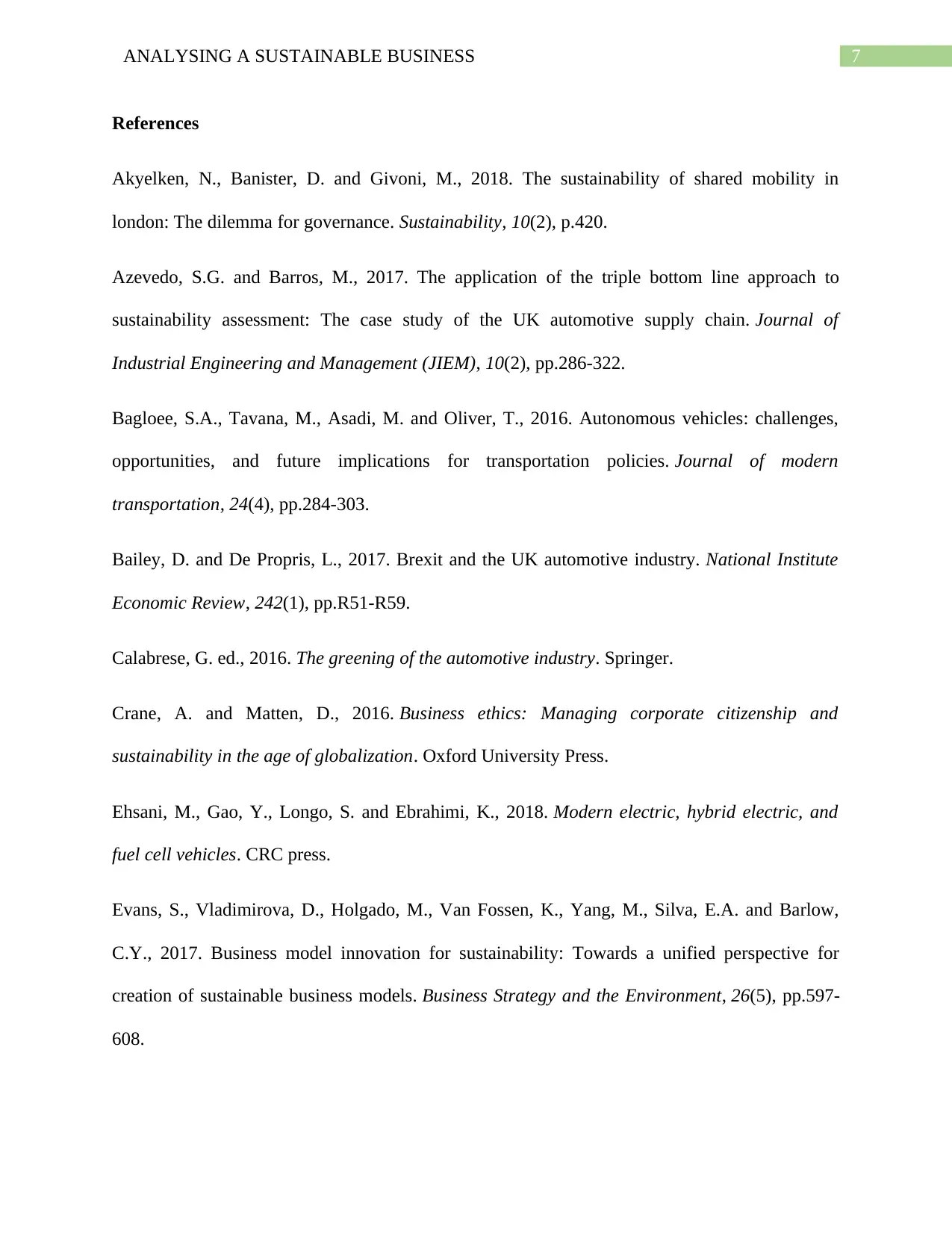
7ANALYSING A SUSTAINABLE BUSINESS
References
Akyelken, N., Banister, D. and Givoni, M., 2018. The sustainability of shared mobility in
london: The dilemma for governance. Sustainability, 10(2), p.420.
Azevedo, S.G. and Barros, M., 2017. The application of the triple bottom line approach to
sustainability assessment: The case study of the UK automotive supply chain. Journal of
Industrial Engineering and Management (JIEM), 10(2), pp.286-322.
Bagloee, S.A., Tavana, M., Asadi, M. and Oliver, T., 2016. Autonomous vehicles: challenges,
opportunities, and future implications for transportation policies. Journal of modern
transportation, 24(4), pp.284-303.
Bailey, D. and De Propris, L., 2017. Brexit and the UK automotive industry. National Institute
Economic Review, 242(1), pp.R51-R59.
Calabrese, G. ed., 2016. The greening of the automotive industry. Springer.
Crane, A. and Matten, D., 2016. Business ethics: Managing corporate citizenship and
sustainability in the age of globalization. Oxford University Press.
Ehsani, M., Gao, Y., Longo, S. and Ebrahimi, K., 2018. Modern electric, hybrid electric, and
fuel cell vehicles. CRC press.
Evans, S., Vladimirova, D., Holgado, M., Van Fossen, K., Yang, M., Silva, E.A. and Barlow,
C.Y., 2017. Business model innovation for sustainability: Towards a unified perspective for
creation of sustainable business models. Business Strategy and the Environment, 26(5), pp.597-
608.
References
Akyelken, N., Banister, D. and Givoni, M., 2018. The sustainability of shared mobility in
london: The dilemma for governance. Sustainability, 10(2), p.420.
Azevedo, S.G. and Barros, M., 2017. The application of the triple bottom line approach to
sustainability assessment: The case study of the UK automotive supply chain. Journal of
Industrial Engineering and Management (JIEM), 10(2), pp.286-322.
Bagloee, S.A., Tavana, M., Asadi, M. and Oliver, T., 2016. Autonomous vehicles: challenges,
opportunities, and future implications for transportation policies. Journal of modern
transportation, 24(4), pp.284-303.
Bailey, D. and De Propris, L., 2017. Brexit and the UK automotive industry. National Institute
Economic Review, 242(1), pp.R51-R59.
Calabrese, G. ed., 2016. The greening of the automotive industry. Springer.
Crane, A. and Matten, D., 2016. Business ethics: Managing corporate citizenship and
sustainability in the age of globalization. Oxford University Press.
Ehsani, M., Gao, Y., Longo, S. and Ebrahimi, K., 2018. Modern electric, hybrid electric, and
fuel cell vehicles. CRC press.
Evans, S., Vladimirova, D., Holgado, M., Van Fossen, K., Yang, M., Silva, E.A. and Barlow,
C.Y., 2017. Business model innovation for sustainability: Towards a unified perspective for
creation of sustainable business models. Business Strategy and the Environment, 26(5), pp.597-
608.
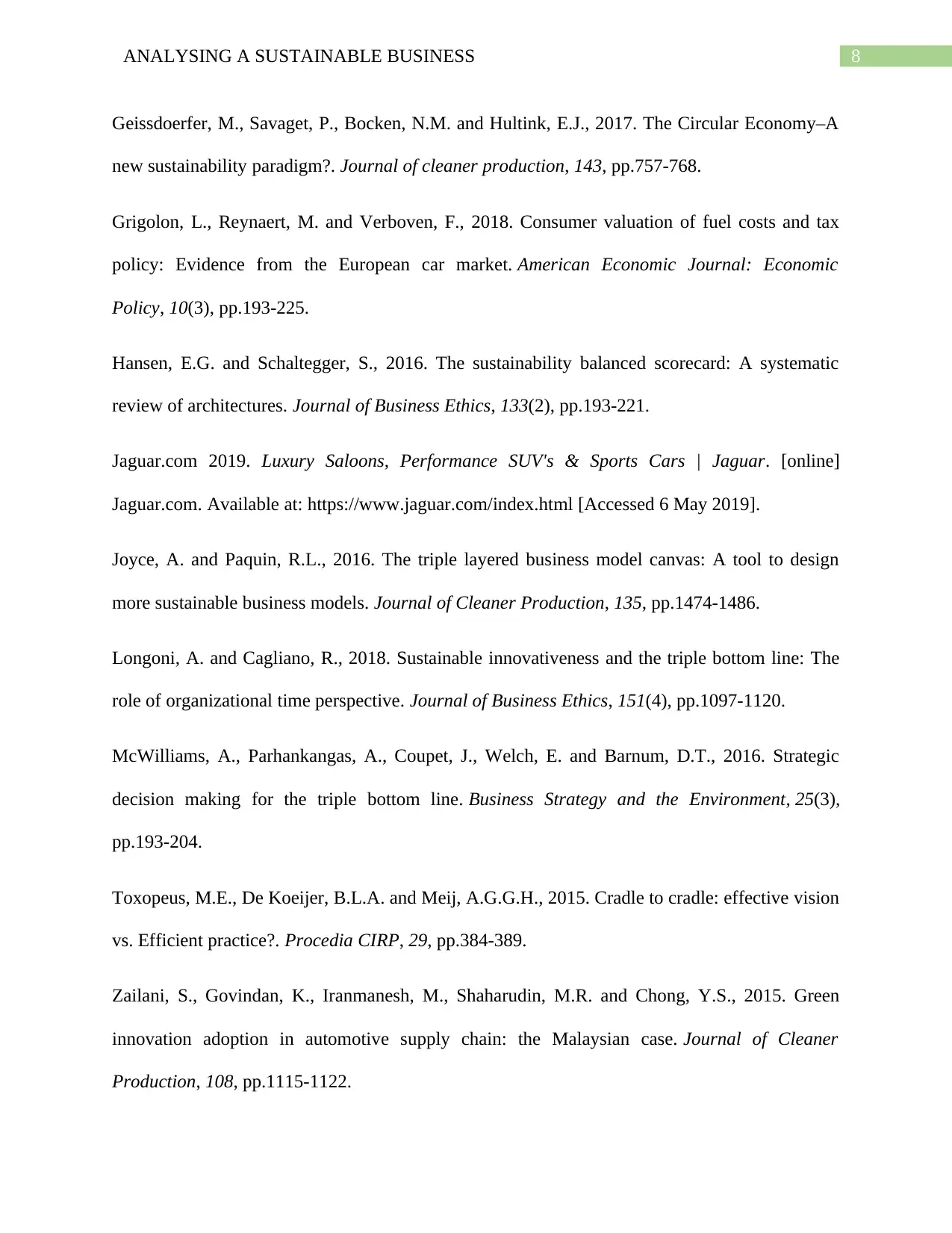
8ANALYSING A SUSTAINABLE BUSINESS
Geissdoerfer, M., Savaget, P., Bocken, N.M. and Hultink, E.J., 2017. The Circular Economy–A
new sustainability paradigm?. Journal of cleaner production, 143, pp.757-768.
Grigolon, L., Reynaert, M. and Verboven, F., 2018. Consumer valuation of fuel costs and tax
policy: Evidence from the European car market. American Economic Journal: Economic
Policy, 10(3), pp.193-225.
Hansen, E.G. and Schaltegger, S., 2016. The sustainability balanced scorecard: A systematic
review of architectures. Journal of Business Ethics, 133(2), pp.193-221.
Jaguar.com 2019. Luxury Saloons, Performance SUV's & Sports Cars | Jaguar. [online]
Jaguar.com. Available at: https://www.jaguar.com/index.html [Accessed 6 May 2019].
Joyce, A. and Paquin, R.L., 2016. The triple layered business model canvas: A tool to design
more sustainable business models. Journal of Cleaner Production, 135, pp.1474-1486.
Longoni, A. and Cagliano, R., 2018. Sustainable innovativeness and the triple bottom line: The
role of organizational time perspective. Journal of Business Ethics, 151(4), pp.1097-1120.
McWilliams, A., Parhankangas, A., Coupet, J., Welch, E. and Barnum, D.T., 2016. Strategic
decision making for the triple bottom line. Business Strategy and the Environment, 25(3),
pp.193-204.
Toxopeus, M.E., De Koeijer, B.L.A. and Meij, A.G.G.H., 2015. Cradle to cradle: effective vision
vs. Efficient practice?. Procedia CIRP, 29, pp.384-389.
Zailani, S., Govindan, K., Iranmanesh, M., Shaharudin, M.R. and Chong, Y.S., 2015. Green
innovation adoption in automotive supply chain: the Malaysian case. Journal of Cleaner
Production, 108, pp.1115-1122.
Geissdoerfer, M., Savaget, P., Bocken, N.M. and Hultink, E.J., 2017. The Circular Economy–A
new sustainability paradigm?. Journal of cleaner production, 143, pp.757-768.
Grigolon, L., Reynaert, M. and Verboven, F., 2018. Consumer valuation of fuel costs and tax
policy: Evidence from the European car market. American Economic Journal: Economic
Policy, 10(3), pp.193-225.
Hansen, E.G. and Schaltegger, S., 2016. The sustainability balanced scorecard: A systematic
review of architectures. Journal of Business Ethics, 133(2), pp.193-221.
Jaguar.com 2019. Luxury Saloons, Performance SUV's & Sports Cars | Jaguar. [online]
Jaguar.com. Available at: https://www.jaguar.com/index.html [Accessed 6 May 2019].
Joyce, A. and Paquin, R.L., 2016. The triple layered business model canvas: A tool to design
more sustainable business models. Journal of Cleaner Production, 135, pp.1474-1486.
Longoni, A. and Cagliano, R., 2018. Sustainable innovativeness and the triple bottom line: The
role of organizational time perspective. Journal of Business Ethics, 151(4), pp.1097-1120.
McWilliams, A., Parhankangas, A., Coupet, J., Welch, E. and Barnum, D.T., 2016. Strategic
decision making for the triple bottom line. Business Strategy and the Environment, 25(3),
pp.193-204.
Toxopeus, M.E., De Koeijer, B.L.A. and Meij, A.G.G.H., 2015. Cradle to cradle: effective vision
vs. Efficient practice?. Procedia CIRP, 29, pp.384-389.
Zailani, S., Govindan, K., Iranmanesh, M., Shaharudin, M.R. and Chong, Y.S., 2015. Green
innovation adoption in automotive supply chain: the Malaysian case. Journal of Cleaner
Production, 108, pp.1115-1122.
⊘ This is a preview!⊘
Do you want full access?
Subscribe today to unlock all pages.

Trusted by 1+ million students worldwide

9ANALYSING A SUSTAINABLE BUSINESS
1 out of 10
Related Documents
Your All-in-One AI-Powered Toolkit for Academic Success.
+13062052269
info@desklib.com
Available 24*7 on WhatsApp / Email
![[object Object]](/_next/static/media/star-bottom.7253800d.svg)
Unlock your academic potential
Copyright © 2020–2025 A2Z Services. All Rights Reserved. Developed and managed by ZUCOL.





